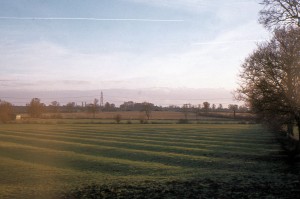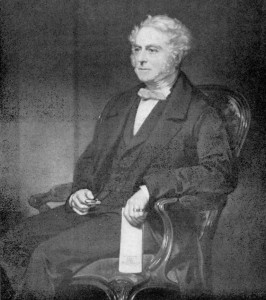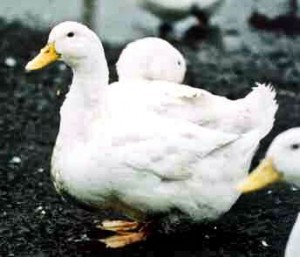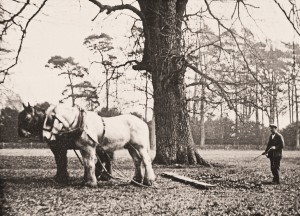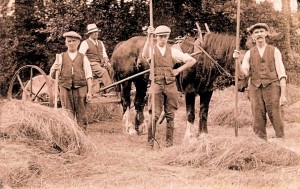Farming in Swanbourne over the years
A History of Farming in Swanbourne
By Frankie Fisher and Ken Harris
In the Middle Ages, Swanbourne would have been farmed on the Open Field system – originally consisting of two fields, and then later, three fields with one field being left fallow each year. The main aim of the farm labourer was to provide food and clothing for himself and his family for the year. Each labourer, unless he was unfree, was allocated, by his lord, strips of land to work distributed over the two or three fields belonging to the village. He would also have to pay his rent in goods or labour, by working several days each week for his lord, and extra “boon work” as it was called at times on ploughing, harrowing, sowing, threshing, hay-making and harvesting. When he had finished this work, he was free to work on his own strips in the field or fields that were being cultivated.
Seed was broadcast and then harrowed to protect it from birds. Weeding was by hand and the weeds dried and fed to cattle. In the fallow year, the ground was ploughed twice.The animals were allowed to graze between ploughings and the dung was then worked in at the second ploughing. The strips were separated by grassy banks for men, carts and ploughs. Ploughing was a communal activity and each plough was pulled by six oxen. Evidence of the ridge and furrow effect of ploughing can still be clearly seen s account he said the ridge and furrow effect was so marked that he, as a young boy, was unable to see above the ridge when he stood in the furrow. The decision to start harvesting was also taken communally. Land in the village was owned by several different lords, so the situation seems quite complicated to us, although probably straightforward to them, because it was what they were used to.
After the Black Death or Bubonic Plague, which reached England in 1348 resulting in the death of nearly half the population, there were too few labourers and an increased reluctance to undertake the work owed to the lord of the manor, especially the additional boonwork at harvest, etc. In 1352, some ‘villeins’ from Winslow escaped and four; William, John and Ralph Adam and Alexander Horsemeleward ended up in Swanbourne, where their labour was probably welcomed and they were protected. A court decision in the Winslow Manorial Court that they should be returned could not be enforced, and none of the rebels returned to Winslow. The Adam brothers may well be the ancestors of the later Adams family in the village.
As time went on, there were probably the first field enclosures, the wages of labourers were increasing and prices were stationary. Wool production was more profitable and needed only a shepherd with dogs. More affluent villagers could keep a pig, but sheep became the dominant livestock, delivering one fleece a year and milk, which was made into cheese. Each ewe produced one lamb. Peas and beans were sown together for fodder, known as dredge, or drage. Animals could be grazed on uncultivated commons such as Haybush Common where Haybush Farm on the Winslow to Whitchurch road is now situated.
By the 18th Century it was hard to find sufficient common pasture. Root crops such as mangolds and swedes were grown as winter fodder. Wintered cattle also provided manure. Later on clover and lucerne were introduced which provided nitrates when their roots were ploughed back in. This meant there was no more need of a fallow year. The seed drill was introduced, so there was no more need for wasteful broadcasting and weeding was quicker with a horse hoe. These factors may have played a decisive part in the decision in 1762 for the large open fields with their many individual strips, to be enclosed, which was carried through the next year, with nearly 50 people receiving awards of land, but many others were left landless and without rights to the commons. (See separate article for details). In 1771, a miniature plough was introduced in some places, which broke up the earth without turning it over.
When Capt. Thomas Fremantle arrived in Swanbourne, the land was still held by many different people, and it was his son, Sir Thomas Fremantle – the first Lord Cottesloe, who gradually consolidated his holding to create the Swanbourne estate which now covers most of the village and was run by an estate manager, sometimes a family member. 1851-75 were good years for farming in Bucks. The home market was protected from competition by foreign wars: The Crimean War and German wars against Denmark, Austria and France and the American Civil War.
More and more land was concentrated on pasture with a much smaller area of crops. Farmers could be flexible, with sheep or beef cattle, dairy cattle or a combination. Demand for labour had fallen because of enclosure; pastoral farming needed fewer workers and the introduction of labour-saving devices aggravated this. War with France, 1793-1815, had meant the import of cereals were reduced which was good for farmers, but when this ended it added to the problem.
Pastures were grazed intensively and cattle were kept indoors in winter and fed on oil-cake and hay. By the middle of the 19th century, butter was still a major product. One cow could produce five pounds of butter a week for about 40 weeks of the year. They were milked by hand twice a day in the fields and the milk was carried back in two pails on a yoke. Pigs were a sideline for a dairy farmer: bred in Berks, stored in Oxfordshire, and finished in our area on skimmed milk and buttermilk. Pork was not eaten when there was an ‘r’ in the month, but porkers were sold to local butchers or sent to London. In the hotter months, pigs were marketed as bacon. The best grazing was often kept for beef cattle. Sheep produced meat for the London market with their wool as a by-product. By 1839, London was just two hours away by rail from Aylesbury. Wheat and barley were grown on arable land, the wheat gave the best straw for bedding and the barley was used for fodder.The development of railways meant that the urban demand for milk, butter, cheese and eggs could be exploited and the costs of the transport of fertilizer, feed, seed, fruit and vegetables was reduced. As the population of the village increased and farming became more efficient, requiring fewer hands, a surplus of labourers was created and wages stagnated, leading to the unrest of the 1860’s and the Agricultural Workers Strike of 1873.
From the name of Duck End, we can assume that ducks were kept in Swanbourne, on the pond by “The Boot”. At this time, a new breed, called the English White, was introduced and became the famous Aylesbury Duck. They fattened quickly in about eight weeks and they could reach 4lb when ready for market. They lived and mated on the pond, broody hens hatched the eggs and the ducklings were often reared in a cottage living room. They were fed three times a day on hard-boiled eggs, barleymeal and beef liver. This small-scale ducking, as it was called, had almost disappeared by the end of the First World War although it sometimes continued where there was a village pond and according to Ken Reading, his parents kept some ducks at Athawes Farm in the years before World War 2.
In the early 20th century, demand for labour fell more, due to the increase in pastoral farming, which needed less workers and the introduction of labour-saving machinery. There was a great farming depression, as imports were made from Europe. Wages could not be cut, because labourers were in short supply. Many from the villages moved to towns like Wolverton and Bletchley to work in the railway companies. It was hard for farmers, a lot of land went out of cultivation and many farmers went bankrupt. Refrigerated steamers and railway carriages brought vast amounts of chilled and frozen meat from the Americas, Australia; this was cheaper and sold well. Market prices favoured milk production. Milk was protected as it did not travel long distances. Between 1895 and 1914, consumption of milk doubled; farmers were also helped by the nearness of the growing London market. Some butter was also imported, but local butter still sold at premium prices.
During World War 1, British agriculture prospered and home-grown wheat produced high prices. A degree of state control over farming was introduced and grassland was ploughed to increase wheat production. The 1917 Corn Production Act was passed, which fixed rent for farmers with a minimum wage for labourers. Between the wars there was a World Trade slump, the fixed price for corn ended and the price dropped. Ken Reading states that his parents suffered badly from the collapse of prices about 1922 and never really recovered confidence in the farming future afterwards.
World War 2 ended the Great Depression. Grants were given to plough up inferior grass land and between 1939 and 1946 wheat acreage doubled, Barley tripled, oats increased but meat, milk, eggs and animal fodder maintained the same level. Prior to the outbreak of war in 1939, the maintenance of some arable land was a condition of letting on many farms. Feed was rationed and horsemeat for human consumption brought a premium price, so many were slaughtered for meat.
At the beginning of World War 2, ploughing had changed very little since mediaeval times. The seed drill and the horse–drawn hoe and the plough all depended on horsepower. During the war every sizable farm obtained a tractor. Horses were stillbred according to Ken Reading, but stock-feed was rationed and horsemeat for human consumption brought a premium price, so many were slaughtered for meat.
The earliest reaping machines that were introduced just cut the corn, which then had to be picked up and bound in sheaves by hand, stooked to dry and then carried back to the farm. It was common for large farms to hire a contractor to thresh the whole crop, using their own machinery. Now of course we have huge combine harvesters.
After the war, the government wanted more of the nation’s food produced at home. Pasture still dominated in our area with the production of milk, beef and lamb. Monetary incentives caused herds to be cleared of TB and hygiene was improved in buildings. But as the cash incentives dried up, Ken Reading said most smallholders, with the exception of Tom Viccars, gave up milking. In 1941 there were 10 farms in milk in Nearton End alone, but by the late 1990s there were four. Now there are none.
Agricultural subsidies were brought in in 1960-61 and by 1965, with the use of tractors and combine harvesters, there was a diminished need for labour. By 1984 we had the E.E.C. milk quotas and milk was no longer collected by churns, but tankers. Set-aside was introduced in 1988 to reduce the food mountains.
Now, in the 21st century, local cattle markets have closed at Aylesbury and Banbury and a number of abattoirs have closed. Everything is regulated. There are still large numbers of sheep, but the number of cattle has dramatically declined and instead we see crops of oilseed rape and cereals.


